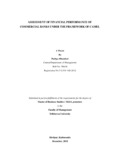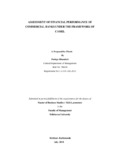Please use this identifier to cite or link to this item:
https://elibrary.tucl.edu.np/handle/123456789/1089Full metadata record
| DC Field | Value | Language |
|---|---|---|
| dc.contributor.author | Bhandari, Pushpa | |
| dc.date.accessioned | 2021-03-10T10:51:23Z | |
| dc.date.accessioned | 2021-07-22T04:58:26Z | - |
| dc.date.available | 2021-03-10T10:51:23Z | |
| dc.date.available | 2021-07-22T04:58:26Z | - |
| dc.date.issued | 2018 | |
| dc.identifier.uri | http://elibrary.tucl.edu.np/handle/123456789/1089 | - |
| dc.description.abstract | The study evaluated the financial performance of commercial banks in Nepal of ten selected sample banks for a five year period from 2012/13 to 2016/17 based on Camel rating approach. The study used the secondary data sourced from the annual reports of the selected banks. CAMEL approach is a tool to measure the bank performance on the basis of Capital adequacy, Asset quality, Management quality, Earning Quality and Liquidity. The collected data were analyzed using both financial and statistical tools. The financial tools used to rate the overall performance of the bank, while correlation coefficient and multiple regression models were used to measure the impact of Camel elements on profitability i.e. ROA and ROE. Financial ratio analysis compares the financial performance among commercial banks, the same bank had different ranks under the different financial ratios. As per the composite rating of CAMEL, the finding of the study revealed that EBL bank stood on the top followed by NIBL and SCBL banks, while NBL bank stood the least position among the selected banks. The correlation analysis revealed that ROA had a positive correlation with Capital, Management, Earning and liquidity which signifies that it helps to increase the profitability of bank. While Asset had negative correlation with ROA. Likewise, ROE had significant positive correlation with Capital Adequacy ratio of Debt equity ratio, Assets quality, Earning ratio of Interest income to total income and liquidity ratio of Liquid asset to Total asset and other ratios were negatively correlated. The regression analysis showed that Capital adequacy, Asset quality, Liquidity had no significant relationship with the selected banks' performance in terms of ROA. On the other hand Management quality and Earning quality ratio of OPTTA was found to be significant relationship to the performance of the bank. While Capital Adequacy ratio of CAR and D/E ratio and Liquidity ratio of LATTA had significant relationship with the selected bank's performance in terms of ROE and other ratios were found to be insignificant relationship to the performance of the bank at 5% significance level. The finding of this study will be helpful to the management of selected banks in making appropriate managerial decision. | en_US |
| dc.language.iso | en_US | en_US |
| dc.publisher | Central Department of Management | en_US |
| dc.subject | Camel | en_US |
| dc.subject | Profitability ratios i.e. ROA and ROE | en_US |
| dc.subject | Financial Performance. | en_US |
| dc.title | Assessment of Financial Performance of Commercial Banks Under the Framework of Camel | en_US |
| dc.type | Thesis | en_US |
| Appears in Collections: | Finance | |
Files in This Item:
| File | Description | Size | Format | |
|---|---|---|---|---|
| Thesis Pushpa.pdf | 931.34 kB | Adobe PDF |  View/Open | |
| Proposal Pushpa.pdf | 289.56 kB | Adobe PDF |  View/Open |
Items in DSpace are protected by copyright, with all rights reserved, unless otherwise indicated.
